toc
Icons in Body Text
Flow of an ABAP Program
Lesson:
System Architecture and ABAP Program
Process Flow of a Program with Selection Screen and List
Topic Overview
Unit 1
Introduction to the ABAP Workbench
Lesson:
Introduction to the Repository
Search Tools in the Repository
Working With the Object Navigator
Lesson:
Organizing Developments
Developing an ABAP Program
Introduction to the ABAP Programming Language
Is typed
The ABAP Editor
Activating Programs
Creating Transactions
Closing Development Projects
Exercise 1: Organizing Developments
Exercise 2: Developing a Simple ABAP Program
Exercise 3: Create Transactions
Basic ABAP Language Elements
Lesson:
Data Types and Data Objects
Using Data Types
ABAP Standard Types
D
C
Local Data Types
Global Data Types
Definition of Variable Data Objects
Literals, Constants and Text Symbols
Comparison: Local and Global Data Types
Basic ABAP Statements
Value Assignments
Calculations and Arithmetic Expressions
Conditional Branches and Logical Expressions
Loops
System Fields
Dialog Messages
Working with the ABAP Debugger
Exercise 4: Basic ABAP Statements
Exercise 5: Debugging Statements on Elementary Data Objects
Modularization
Lesson:
Modularization Technique
Local Program Modularization
Global Modularization
Encapsulating Data
Data Transports, Parameters and Interface
Lesson:
Internal Program Modularization with Subroutines
Parameter Definition for Subroutines
Local and Global Data Objects
Calling Subroutines
Modularization Units in the Debugger
Exercise 6: Subroutines
Lesson:
Working with Function Modules
Searching for Function Modules
Function Module Interface
Documentation and Testing
Calling Function Modules
Exception Handling
Creating Function Groups and Function Modules
Creating Function Groups
Creating Function Modules
Working with BAPIs
GetList
Exercise 7: Using a Function Module
Exercise 8: Creating a Function Group
Exercise 9: Creating and Using a Function Module
Lesson:
Principles of Object-Oriented Programming
Classes, Attributes, and Methods
Encapsulating Data, Public and Private Components
Multiple Instantiation of Classes
Instance Components and Static Components
Using Methods of Global Classes
Attributes of Global Classes
Methods and Their Signature
Documentation and Testing
Calling Static Methods
Exception Handling
Handling Classic Exceptions
Handling Class-Based Exceptions
Generating Instances and Calling Instance Methods
Creating Global Classes and Static Methods
Creating Global Classes
Creating a Static Method
Exercise 10: Using Global Static Methods
Exercise 11: Creating Global Classes
Exercise 12: Creating and Using Global Static Methods
Lesson:
Defining and Using Local Classes
Complex Data Objects
Lesson:
Working with Structures
Exercise 13: Working with Structures
Lesson:
Working with Internal Tables
Exercise 14: Working with Internal Tables
Data Modeling and Data Retrieval
Lesson:
Data Modeling
Transparent Tables
Exercise 15: Analyzing Transparent Tables in the ABAP Dictionary
Lesson:
Data Retrieval
Performance Aspects with Database Access
Secondary Index
SAP Table Buffer
Reading from Several Database Tables
Database Change Accesses (Preview)
Exercise 16: Data Retrieval by Single Record Access
Exercise 17: Data Retrieval Using a SELECT Loop
Exercise 18: (Optional) Data Retrieval by Mass Access (Array Fet
Lesson:
Authorization Checks
Exercise 19: Authorization Check
User dialogs
Lesson:
The Screen
Screens, Pushbuttons and Navigation
Screens, Creating Input/Output Fields
Data Transports Between the Program and the Screen
Exercise 20: Creating Screens and Dynamic Next Screen Processing
Exercise 21: Screen – Creating Input/Output Fields
Exercise 22: Screens – Data Transport
Lesson:
ABAP Web Dynpro: Properties and Programming Model
Elements of the ABAP Web Dynpro
Web Dynpro, Pushbuttons and Navigation
Creating a Web Dynpro Component
Creating Web Dynpro Views and Embedding them in the Window
Setting up Navigation Between Web Dynpro Views
Creating Pushbuttons and Triggering Navigation
Creating a Web Dynpro Application
Web Dynpro, Layout and Data Transport
Creating a Web Dynpro Service Call and Generating the Controller
A service method (name begins with “ EXECUTE_ ” )
Setting up Context Mapping
Creating Input/Output Fields and Setting up Data Binding
Calling the Service Method for Data Retrieval
Exercise 23: Web Dynpro:Navigation
Exercise 24: Web Dynpro: Data Transport and Layout
Lesson:
ABAP List
Selection Screen
Advantages of Selection Screens
Input Options on Selection Screens
ABAP Events
Event Block Characteristics
The INITIALIZATION Event
The AT SELECTION-SCREEN Event
Other ABAP Events
Exercise 25: Selection Screen and Classic ABAP List
Task 1:
Exercise 26: ABAP Events
Lesson:
The SAP List Viewer
Exercise 27: Displaying an Internal Table with the SAP List View
Tools for Program Analysis
Lesson:
Introduction
Calling the Code Inspector
Defining Check Variants, Object Sets and Inspections
Adjusting the SAP Standard Software (Overview)
Lesson:
Basic Terms and Options of SAP Software Adjustment
Enhancement Types
Append structure
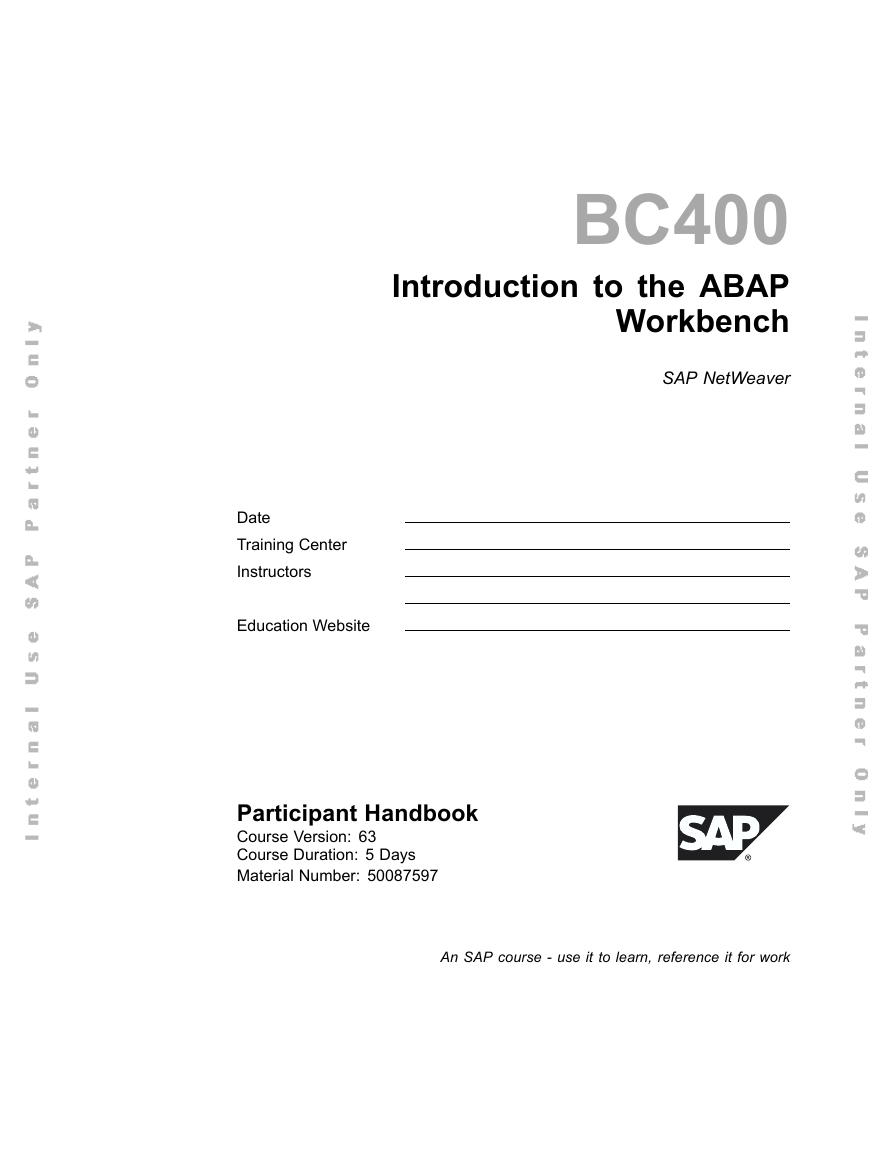

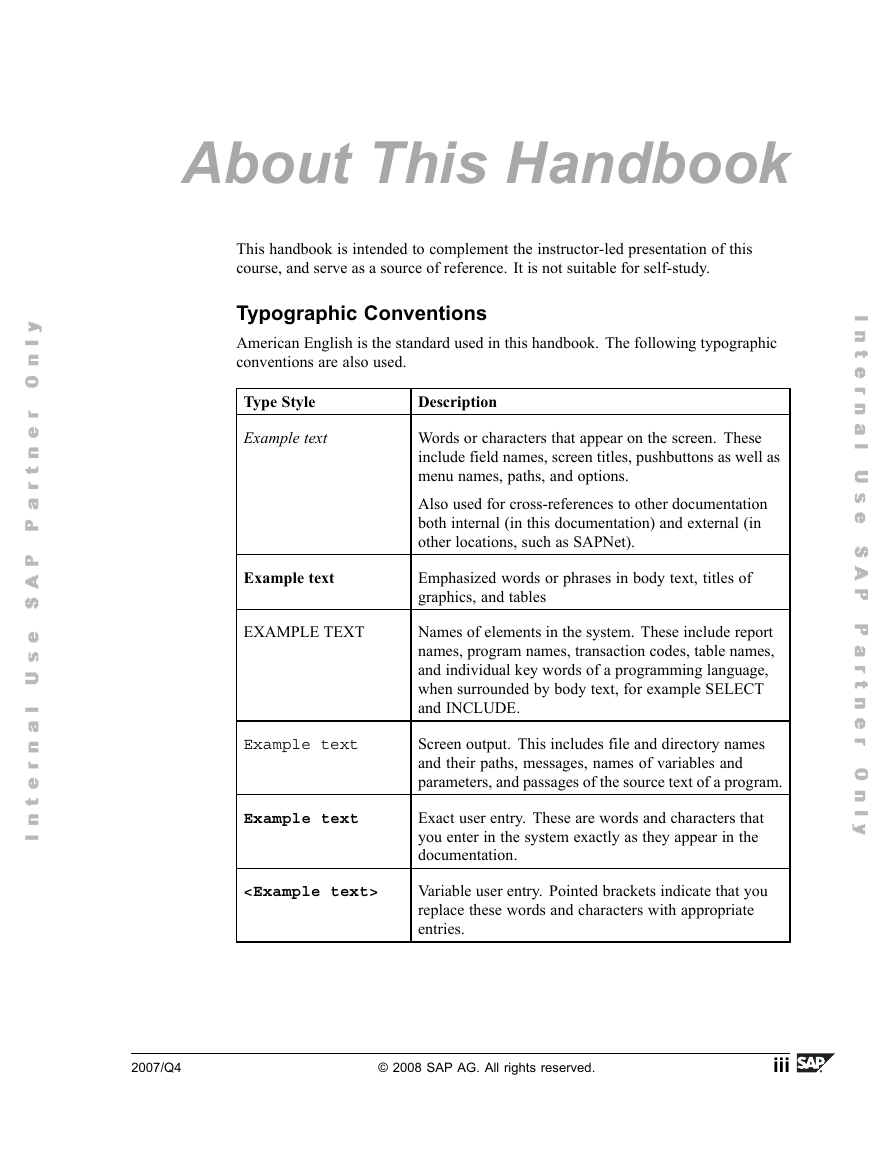

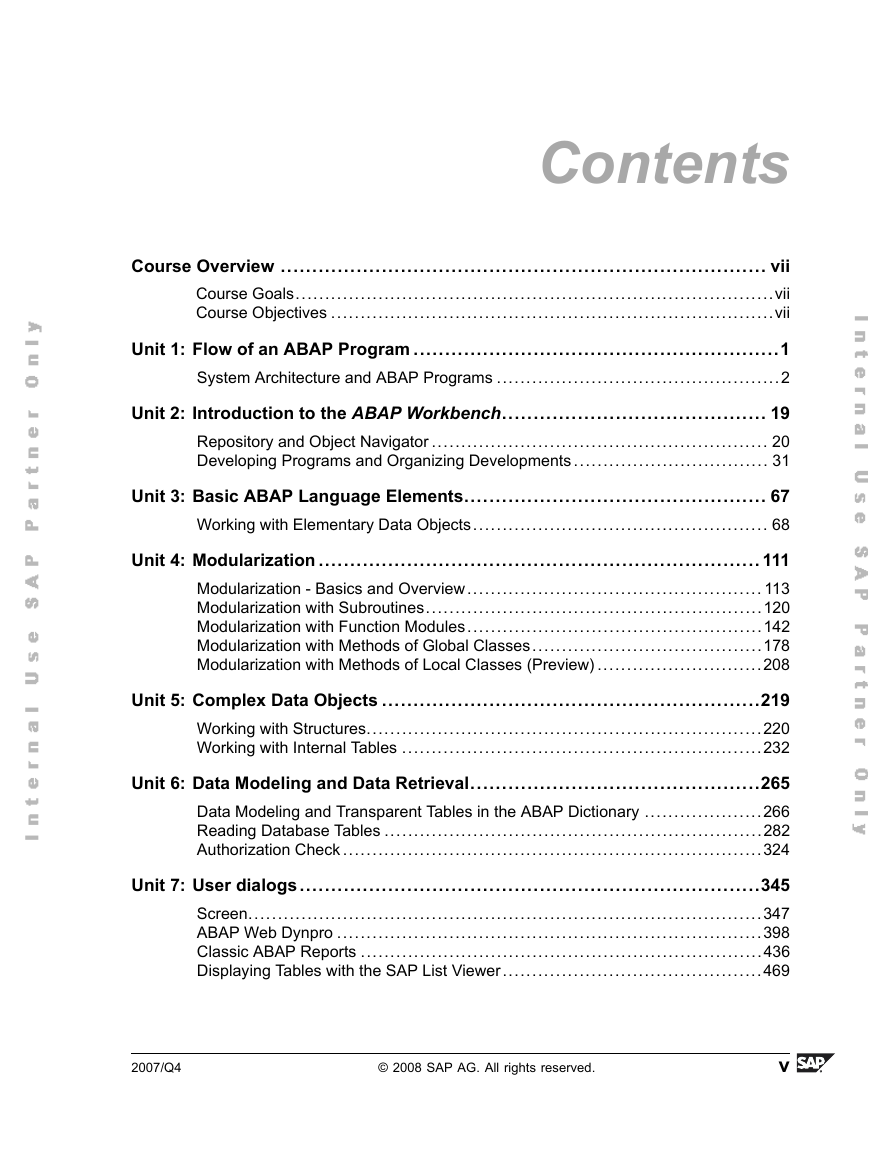
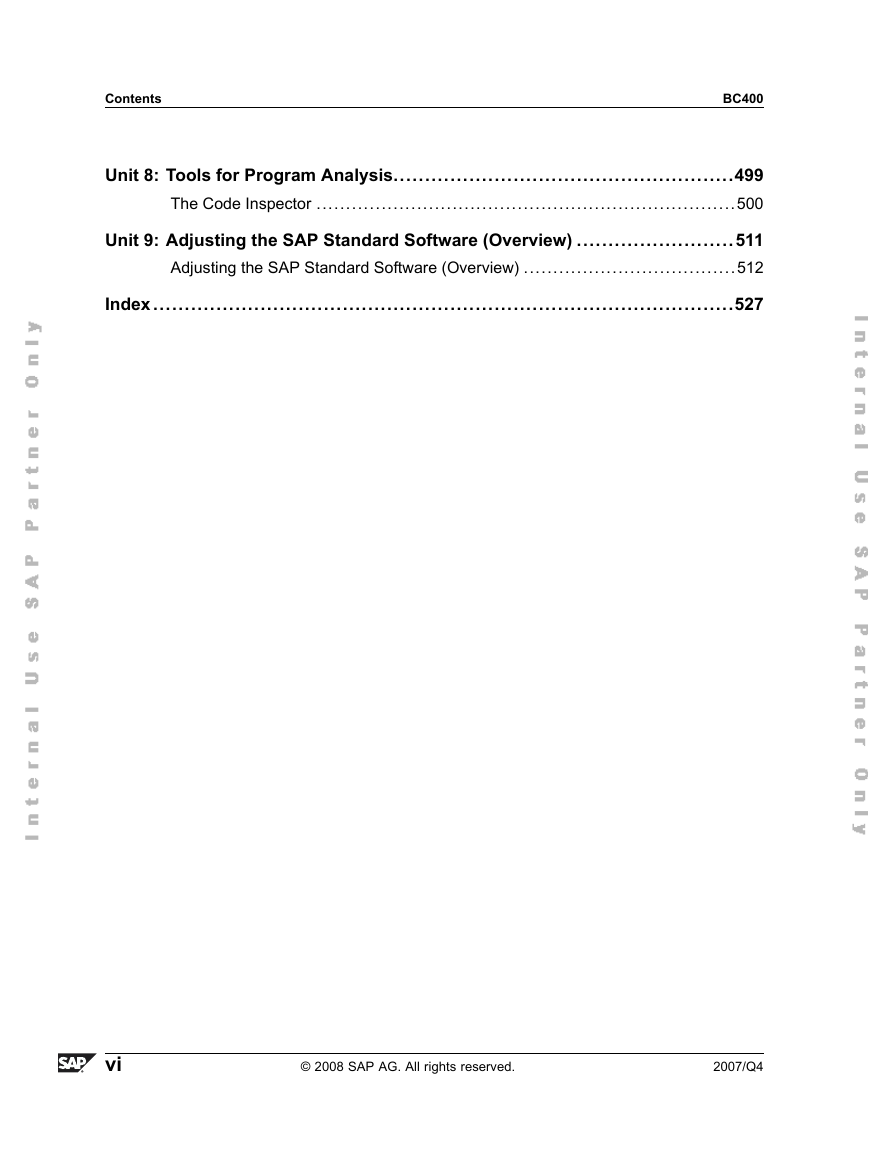

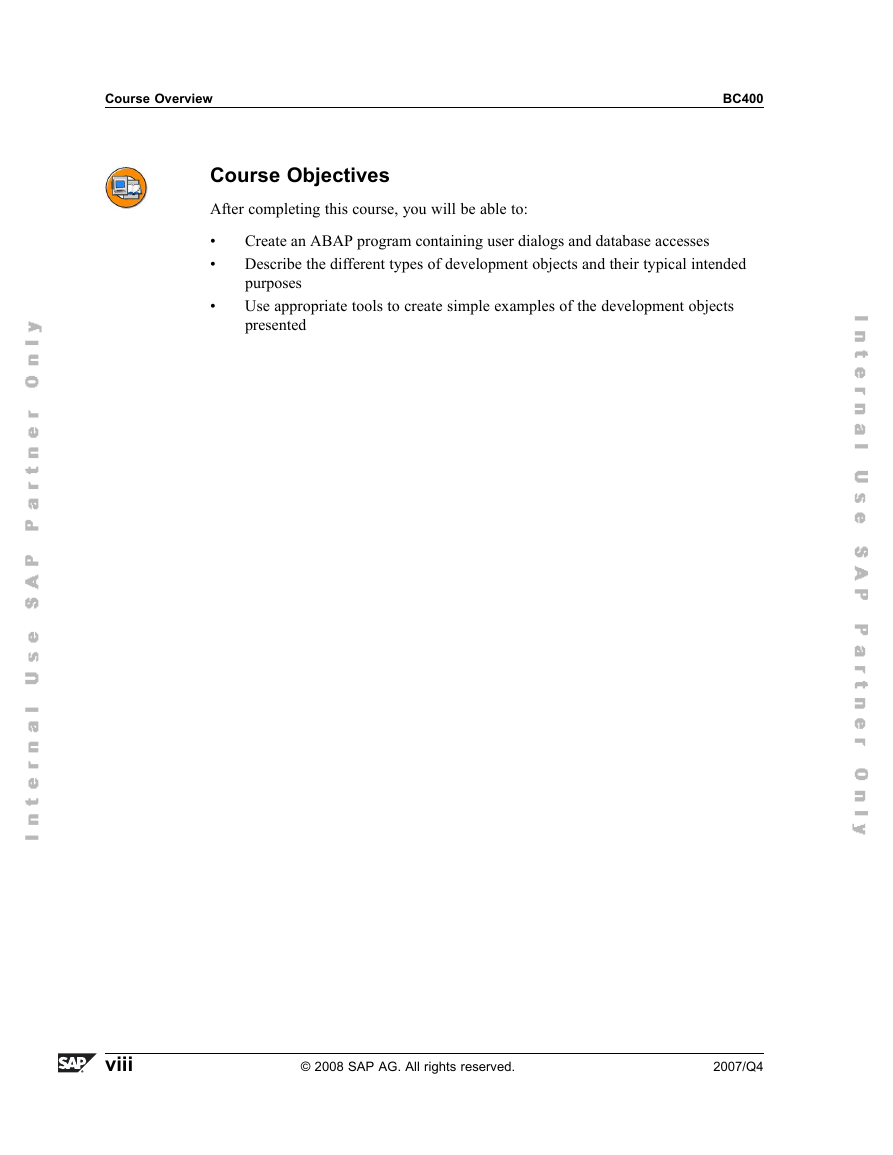








 2023年江西萍乡中考道德与法治真题及答案.doc
2023年江西萍乡中考道德与法治真题及答案.doc 2012年重庆南川中考生物真题及答案.doc
2012年重庆南川中考生物真题及答案.doc 2013年江西师范大学地理学综合及文艺理论基础考研真题.doc
2013年江西师范大学地理学综合及文艺理论基础考研真题.doc 2020年四川甘孜小升初语文真题及答案I卷.doc
2020年四川甘孜小升初语文真题及答案I卷.doc 2020年注册岩土工程师专业基础考试真题及答案.doc
2020年注册岩土工程师专业基础考试真题及答案.doc 2023-2024学年福建省厦门市九年级上学期数学月考试题及答案.doc
2023-2024学年福建省厦门市九年级上学期数学月考试题及答案.doc 2021-2022学年辽宁省沈阳市大东区九年级上学期语文期末试题及答案.doc
2021-2022学年辽宁省沈阳市大东区九年级上学期语文期末试题及答案.doc 2022-2023学年北京东城区初三第一学期物理期末试卷及答案.doc
2022-2023学年北京东城区初三第一学期物理期末试卷及答案.doc 2018上半年江西教师资格初中地理学科知识与教学能力真题及答案.doc
2018上半年江西教师资格初中地理学科知识与教学能力真题及答案.doc 2012年河北国家公务员申论考试真题及答案-省级.doc
2012年河北国家公务员申论考试真题及答案-省级.doc 2020-2021学年江苏省扬州市江都区邵樊片九年级上学期数学第一次质量检测试题及答案.doc
2020-2021学年江苏省扬州市江都区邵樊片九年级上学期数学第一次质量检测试题及答案.doc 2022下半年黑龙江教师资格证中学综合素质真题及答案.doc
2022下半年黑龙江教师资格证中学综合素质真题及答案.doc